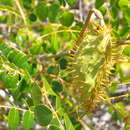Comprehensive Description
provided by North American Flora
Guilandina ciliata Berg.; Wickstr. Sv. Vet. Akad. Handl 18252:431. 1825.
Caesalpinia Grisebachiana Kuntze. Rev. Gen. 166. 1891.
Guilandina Grisebachiana Krug & Urban; Duss. Fl. Ant. Franc. 229. 1897.
Caesalpinia ciliata Urban. Symb. An(. 2: 275. 1900.
Vine-like, the branches, petioles, leaf-rachis and inflorescence tomentulose, the branches and petioles more or less prickly. Stipules obsolete or wanting; pinnae 5-8 pairs; rachis and rachillas prickly; leaflets 4-8 pairs, oval to suborbicular, inequilateral, 1.5-3 cm. long, subchartaceous, glabrate, paler green beneath than above, the apex rounded or emarginate, the base obliquely obtuse, rounded or subtruncate; racemes tomentose, slender-peduncled, manyflowered, 7 cm. long, or longer; pedicels 3-7 mm. long; calyx 7 or 8 mm. long; legume obliquely short-oval, 5-8 cm. long, sparingly prickly, the nearly straight beak about 1 cm. long; seeds yellow to orange, horizontally striate, subglobose, 1.5-2 cm. in diameter.
Type locality: St. Barts.
Distribution: Hispaniola; St. Barts; St. Martin; Saba; Guadeloupe; Martinique (?); Antigua (?) ; Curaf ao.
- bibliographic citation
- Nathaniel Lord Britton and Joseph Nelson Rose. 1928. (ROSALES); MIMOSACEAE. North American flora. vol 23(1). New York Botanical Garden, New York, NY
Physical Description
provided by USDA PLANTS text
Perennial, Shrubs, Vines, twining, climbing, Woody throughout, Stems erect or ascending, Stems or branches arching, spreading or decumbent, Stems 1-2 m tall, Stems greater than 2 m tall, Trunk or stems armed with thorns, spines or prickles, Stems solid, Stems or young twigs sparsely to densely hairy, Leaves alternate, Leaves petiolate, Stipules conspicuous, Stipules setiform, subulate or acicular, Stipules deciduous, Stipules free, Leaves compound, Leaves even pinnate, Leaves bipinnate, Leaf or leaflet margins entire, Leaflets opposite, Leaflets alternate or subopposite, Leaflets 10-many, Leaves glabrous or nearly so, Leaves hairy on one or both surfaces, Inflorescences racemes, Inflorescence axillary, Inflorescence terminal, Bracts conspicuously present, Flowers actinomorphic or somewhat irregular, Calyx 5-lobed, Calyx hairy, Petals separate, Petals clawed, Petals orange or yellow, Petals bicolored or with red, purple or yellow streaks or spots, Banner petal narrow or oblanceolate, Banner petal ovoid or obovate, Wing petals narrow, oblanceolate to oblong, Wing tips obtuse or rounded, Keel tips obtuse or rounded, not beaked, Imperfect flowers present, dioecious or polygamodioecious, Stamens 9-10, Stamens completely free, separate, Stamens long exserted, Filaments glabrous, Style terete, Fruit a legume, Fruit unilocular, Fruit tardily or weakly dehiscent, Fruit orbicular to subglobose, Fruit exserted from calyx, Fruit inflated or turgid, Fruit spiny, bur-like, with hooked bristles or prickles, Fruit hairy, Fruit 1-seeded, Fruit 2-seeded, Fruit 3-10 seeded, Seeds ovo id to rounded in outline, Seed surface smooth, Seed surface wrinkled or rugose, Seeds red, or scarlet and black, Seeds olive, brown, or black.

